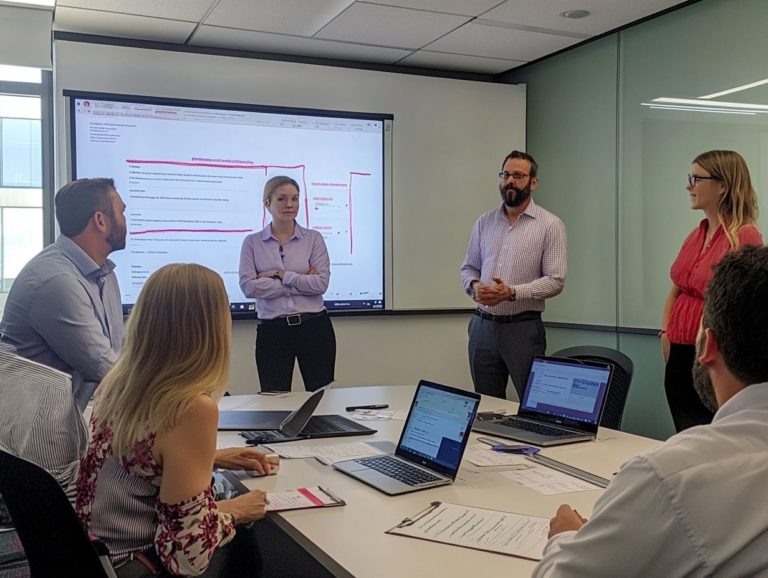Performance Management Tools: Trends to Watch
In today’s fast-paced work environment, effective performance management is more essential than ever. This article explores the latest trends in performance management tools, emphasizing the shift towards continuous evaluation, the integration of cutting-edge technologies, and a heightened focus on employee engagement.
You’ll discover the myriad benefits these tools provide, from boosting productivity to enhancing decision-making capabilities. However, it’s important to also consider the challenges they present, including potential biases and resistance to change.
As you look ahead, you’ll encounter future developments and emerging technologies that are poised to shape this critical aspect of workplace dynamics. Dive in to uncover how these tools can revolutionize performance management for your organization.
Contents
- Key Takeaways:
- Current Trends in Performance Management Tools
- Benefits of Using Performance Management Tools
- Challenges and Limitations of Performance Management Tools
- Future of Performance Management Tools
- Frequently Asked Questions
- What are some current trends in performance management tools?
- How is artificial intelligence being used in performance management tools?
- What is continuous performance management and why is it becoming popular?
- How are performance management tools incorporating employee feedback and recognition?
- Are there any trends in performance management tools that are focused on employee development?
- How can performance management tools benefit both employees and organizations?
Key Takeaways:
- Performance management tools are used to measure and improve employee performance.
- The current trends in performance management tools include a shift towards continuous performance management, incorporation of artificial intelligence, and a focus on employee engagement and development.
- Benefits of using performance management tools include improved employee performance and productivity, as well as enhanced data analysis and decision-making.
What are Performance Management Tools?
Performance management tools are designed to elevate your organization’s success by streamlining employee evaluations, tracking performance metrics, and incorporating continuous feedback systems. These tools empower you to cultivate a collaborative culture that nurtures employee growth and engagement while aligning individual contributions with your organization’s main goals.
Using technologies like digital portfolios and support systems can help you take control of performance management trends and insights, leading to enhanced decision-making.
Take Google, for instance; they employ objective and key results (OKRs) to establish clear, measurable goals, inspiring employees to pursue excellence while providing a framework for ongoing assessments. Similarly, Amazon conducts regular performance reviews that resonate deeply with its leadership principles, highlighting customer obsession and innovation.
These tools not only facilitate structured goal setting and periodic evaluations but also create an environment where feedback becomes an integral part of daily practices. This focus on feedback cultivates a growth mindset, empowering individuals to continuously improve and adapt, ultimately enhancing the overall performance of your organization.
Current Trends in Performance Management Tools
The landscape of performance management is evolving at a remarkable pace. Organizations increasingly embrace tools that prioritize continuous feedback and real-time performance tracking.
This shift underscores a growing acknowledgment of employee engagement’s critical role and the necessity for adaptable processes that can respond to the dynamic nature of workplace cultures and organizational demands.
Companies use innovative tools to cultivate an agile performance management environment, fostering both accountability and empowerment among their employees.
Shift Towards Continuous Performance Management
The shift towards continuous performance management represents a pivotal evolution in how you approach employee evaluation and feedback. Unlike traditional methods that often depend on annual performance reviews, this new paradigm emphasizes regular, real-time feedback that enhances both employee satisfaction and engagement.
It also cultivates a growth mindset and fosters more adaptive processes aligned with performance trends and organizational goals.
By incorporating ongoing check-ins and dynamic goal-setting, you enable your teams to feel more connected to their work. Companies like GE and Google are leading the charge, showcasing how continuous performance management strengthens communication channels and allows for quicker identification of employee strengths and areas needing improvement.
As a result, the performance review process transforms from a daunting once-a-year affair into an ongoing dialogue that significantly boosts morale. This continual engagement nurtures a culture where employees feel empowered and more satisfied, ultimately helping you retain top talent and maintain elevated levels of productivity.
Incorporation of Artificial Intelligence
The integration of artificial intelligence (AI) into performance management tools marks a significant evolution in enhancing the precision and efficiency of performance evaluations. By harnessing AI-driven analytics, you can uncover valuable insights into performance and make informed, data-driven decisions that elevate employee development and engagement. This technology helps your organization quickly identify performance trends and implement customized training programs that align with individual career aspirations.
Take, for example, organizations like Workhuman and Engagedly, which employ AI for real-time performance tracking. This empowers managers to receive instant feedback on their teams’ progress, fostering a more dynamic approach to performance management. With this immediate visibility, you can make timely adjustments to address any challenges or seize on emerging strengths.
Predictive analytics further enable you to anticipate potential employee hurdles, paving the way for proactive interventions. Embracing these tools refines performance measurement and nurtures a culture of continuous improvement that promotes open dialogue and deepens employee engagement.
Focus on Employee Engagement and Development
A growing emphasis on employee engagement and development is transforming the objectives of performance management tools, highlighting their vital role in nurturing a growth mindset within organizations. By prioritizing talent development and implementing effective feedback mechanisms, you can create structured support systems that encourage continuous learning and improvement among your employees. This focus enhances individual performance and contributes to your organization’s success.
In this evolving landscape, innovative performance management tools act as catalysts for fostering collaboration and transparency. They facilitate regular check-ins and peer feedback, providing employees with diverse perspectives on their performance while building a sense of community and support.
By incorporating data analytics, you can track progress and identify areas for growth, ensuring your employees feel valued and recognized for their contributions.
This comprehensive approach to performance management boosts morale and aligns personal development with the broader goals of your organization.
Benefits of Using Performance Management Tools
Utilizing performance management tools unlocks a wealth of benefits that can greatly elevate both employee performance and overall organizational productivity.
These tools enable you to streamline performance evaluations, encourage transparent communication, and harness analytical insights for well-considered choices.
Focusing on performance metrics and continuous feedback, you can cultivate a culture of accountability and innovation that drives employee growth and enhances satisfaction across the board.
Improved Employee Performance and Productivity
One of the most significant advantages you’ll discover with performance management tools is a boost in employee performance and productivity. By consistently tracking performance metrics and providing ongoing feedback, these tools enable you to help employees understand their strengths and identify areas for improvement, ultimately enhancing their output and efficiency. Organizations that embrace such strategies often notice a direct link between effective performance management and a surge in overall productivity.
Microsoft and Amazon have successfully utilized these strategies. Microsoft’s introduction of a feedback culture revolutionized team collaboration, concentrating on measurable outcomes like project completion rates and individual contributions. Similarly, Amazon utilizes data-driven evaluations to monitor employee effectiveness, employing key performance indicators such as customer satisfaction scores and delivery timelines.
These metrics clarify expectations and empower employees to take ownership of their work. Real-time insights help employees spot areas for improvement, leading to a more engaged and motivated workforce. It’s clear that performance management tools are vital instruments for nurturing talent and driving organizational success.
Enhanced Data Analysis and Decision Making
Enhanced data analysis capabilities provided by performance management tools can significantly elevate your decision-making processes. These tools provide detailed performance data, allowing you to make informed decisions based on accurate, real-time information about employee contributions and organizational performance. This helps your organization quickly adapt to industry changes and effectively optimize talent development strategies.
Consider tools like SAP SuccessFactors and Workday; they deliver a wealth of performance data and pinpoint areas where employees excel or may need additional support. With these insights, you can align individual employee goals more closely with broader organizational objectives, ensuring that everyone is working toward the same vision. This alignment fosters a sense of purpose and motivation among your team, ultimately leading to heightened productivity and job satisfaction.
By tracking performance trends over time, your organization can make strategic adjustments that will keep you competitive in your market.
Challenges and Limitations of Performance Management Tools
While performance management tools have many benefits, challenges can limit their effectiveness. Factors such as potential biases in evaluations, inaccuracies in feedback mechanisms, and resistance to change among employees can obstruct the successful implementation of these tools.
Tackling these challenges is essential for ensuring that performance management tools fulfill their intended purpose and cultivate a positive workplace culture.
Potential Biases and Inaccuracies
One significant challenge you may encounter when using performance management tools is the potential for biases and inaccuracies that can skew performance evaluations. These biases often arise from subjective feedback systems or flawed accountability measures, which can lead to distorted assessments of employee contributions and performance metrics. Understanding and addressing these biases is crucial for cultivating an equitable workplace culture.
This distortion can affect morale and dampen engagement, as individuals might feel undervalued or misrepresented in management’s eyes. Such sentiments frequently result in decreased productivity and increased turnover, complicating team dynamics.
To address these challenges, prioritize developing clear evaluation criteria. Regular feedback mechanisms can also help.
By implementing data-driven approaches, such as peer reviews or performance analytics, you can significantly enhance fairness in evaluations. This minimizes the sway of personal biases, ensuring that all employees are assessed based on their actual performance and contributions.
Resistance to Change and Adoption
Resistance to change is a common challenge you may encounter when implementing performance management tools in your organization. Employees may hesitate to embrace new systems due to fear or skepticism about their effectiveness. This resistance can hinder the successful integration of performance management practices and disrupt workplace culture.
Understanding these concerns is crucial, as it reveals deeper layers of employee apprehensions, including perceived threats to job security and doubts about how these new processes will affect their roles. The anxiety stemming from prior negative experiences with change can further entrench this reluctance. To combat this, organizations should offer targeted training programs. Clear communication can also invite feedback and clear up misconceptions.
Involve employees in the transition process and encourage open dialogue to create an inclusive environment that embraces innovation and respects the workplace culture.
Future of Performance Management Tools
The future of performance management tools will change significantly as emerging technologies and industry trends reshape the landscape. Organizations increasingly acknowledge the significance of adaptive processes and innovative tools.
These tools not only enhance performance evaluations but also actively support employee engagement and career development. They will integrate seamlessly with AI, providing real-time insights and enabling data-driven decision-making to optimize success within your organization.
Predictions and Emerging Technologies
Predictions about the future of performance management tools suggest that you are on the brink of a revolution, due to emerging technologies like artificial intelligence and advanced analytics. These innovations will transform the way you manage employee performance, allowing for more accurate evaluations, real-time feedback, and customized development programs.
The result? Enhanced productivity and engagement in your workplace. By harnessing AI algorithms, your organization can sift through vast amounts of employee data to spot patterns and forecast performance trends, paving the way for proactive interventions.
Advanced analytics will provide you with deeper insights into team dynamics and the unique strengths of each contributor, enabling the creation of personalized career pathways that truly resonate.
Imagine using AI-driven chatbots for instant feedback and coaching. This empowers employees to aim for continuous improvement. As you embrace these cutting-edge tools, fostering a culture of continuous improvement won’t just be achievable—it will become essential. This shift will promote adaptive learning and drive your organization towards lasting success.
Frequently Asked Questions
What are some current trends in performance management tools?
Current trends in performance management tools include the use of AI and data analytics, a shift to continuous performance management, and incorporating employee feedback and recognition.
How is artificial intelligence being used in performance management tools?
Artificial intelligence automates tasks such as data analysis, feedback collection, and goal setting, streamlining processes and making them more efficient.
What is continuous performance management and why is it becoming popular?
Continuous performance management involves monitoring and evaluating performance on an ongoing basis, rather than through traditional annual or bi-annual reviews. It is becoming popular because it allows for more frequent and timely feedback and adjustments.
How are performance management tools incorporating employee feedback and recognition?
Many performance management tools now include features for employees to provide feedback on their performance and colleagues. Managers can easily recognize and reward employees for their achievements and contributions.
Are there any trends in performance management tools that are focused on employee development?
Yes, there has been a shift towards using performance management tools to support employee development and growth, which can include tools for setting and tracking individual development goals, providing personalized learning resources, and conducting career conversations.
How can performance management tools benefit both employees and organizations?
Performance management tools benefit employees by providing continuous feedback, development opportunities, and recognition. For organizations, these tools can improve employee performance, engagement, and retention, leading to increased productivity and success.

.jpg_00.jpeg)
.jpg_01.jpeg)
.jpg_10.jpeg)
.jpg_11.jpeg)



